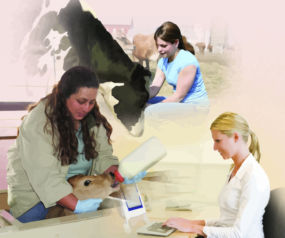So it’s clear that conventional dairies aren’t going anywhere anytime soon. But comparing the efficiency of each model isn’t an apples-to-apples comparison. It requires taking a close look at the key metrics for robotic and conventional dairies.
In the details
In a conventional dairy, the turns per hour in the parlor is a key metric – about 75 to 80 cows per hour per milker is typical. That level of production can decrease, however, if labor availability becomes further constrained, which is one of the biggest industry concerns right now (and a big reason why robots have gained so much traction to begin with).
In the robot world, box time is the important benchmark – less than eight minutes per cow is standard. Prep time and milk time remain constant, so attach time is crucial for improving efficiency. With the continual improvement occurring in the new robotic systems, attach times are continuing to decline, and we expect to see box times of six minutes or less in the near future.
As in a conventional dairy, daily milk production per cow is still an important metric in a robotic facility. But because of the capital investment intensity of a robotic facility, a better measure is daily milk production per robot. The top operations we see achieve a daily output of 5,500 pounds of milk per robot. That number will slide even higher as the technology improves, allowing for more cows to move through a system each day.
In a robotic facility, along with essential daily metrics such as milking frequency, milking intervals and daily milkings, you also need to track robot-specific measurements such as robot utilization and incomplete milking. The challenge is making sure the information you’re monitoring is the impactful data and not just the “fun facts.”
Trading debt for labor
Another key area of focus is your net cost of production. On a traditional operation, as Figure 1 illustrates, maintaining less than $20 of debt per hundredweight (cwt) puts you in the green. For a robotic dairy, under $25 of debt per cwt is considered in the green because of the labor efficiencies you can achieve.

Allocation of debt payments compared to labor costs also varies between robotic and conventional dairy operations. Within your net cost of production, you should also look at the breakdown in your capital and labor expenses. The current standard metric is $5 of debt per cwt for capital and labor. In a robotic facility, however, more of your expenditures are allocated to capital investment costs (debt payments), whereas conventional dairies spend more on labor. In a typical conventional operation, that $5 is split relatively evenly, with $2.50 for capital debt and $2.50 for labor. In a robotic facility, it’s typically in the range of $3.50 for capital and $1.50 for labor.
We have recently seen an interesting trend toward hybrid systems, which combine the conventional parlor dairy with a robotic barn system in the same operation. Applying the right metrics in these operations is more complicated. The overall labor spending will look better because of the efficiencies on the robotic side of the operation. Also, these operations gain efficiencies because they can pick and choose which cows use the robots without losing efficiency in the parlor, which can lead to misleading overall results when compared to fully robotic facilities. This picking and choosing eliminates concerns of cow adaptation to robotic systems, as they can simply be switched back to the conventional system if needed.
That’s why in hybrid operations, daily milk production per cow is, in most cases, the only metric you can reliably use for the whole farm, unless you have an enterprise accounting system with which you can track each model separately.
In the end, it’s important to note that your operation’s overall financial metrics are the same regardless of operation – that includes your return on assets, margin after debt service and balance sheet components, including working capital, current ratio and equity. And whether you’re a conventional or robotic operation, you still need a cushion to protect against market volatility.
Ultimately, while the specific metrics for measuring the efficiency of conventional and robotic facilities vary, the underlying fundamentals remain the same. ![]()
Craig Rogan is a vice president of business banking at BMO Harris Bank. Email Craig Rogan or call him at (715) 342-3270.
Brad Guse is BMO Harris Bank’s senior vice president of agricultural banking. Email Brad Guse or call him at (715) 486-3043. For more agriculture industry insights, visit the BMO Harris Bank website.

-
Craig Rogan
- Vice President of Business Banking
- BMO Harris Bank
- Email Craig Rogan

-
Brad Guse
- Senior Vice President of Agricultural Banking
- BMO Harris Bank
- Email Brad Guse
Note: The opinions, estimates and projections, if any, contained in this article are those of the authors. For this article and the insights found at the link above, BMO Harris Bank endeavors to ensure that the contents have been compiled or derived from sources that it believes to be reliable and which it believes contain information and opinions that are accurate and complete. However, the authors and BMO Harris Bank take no responsibility for any errors or omissions, and accepts no liability whatsoever for any loss (whether direct or consequential) arising from any use of or reliance on these articles or their contents. These articles are for informational purposes only.













